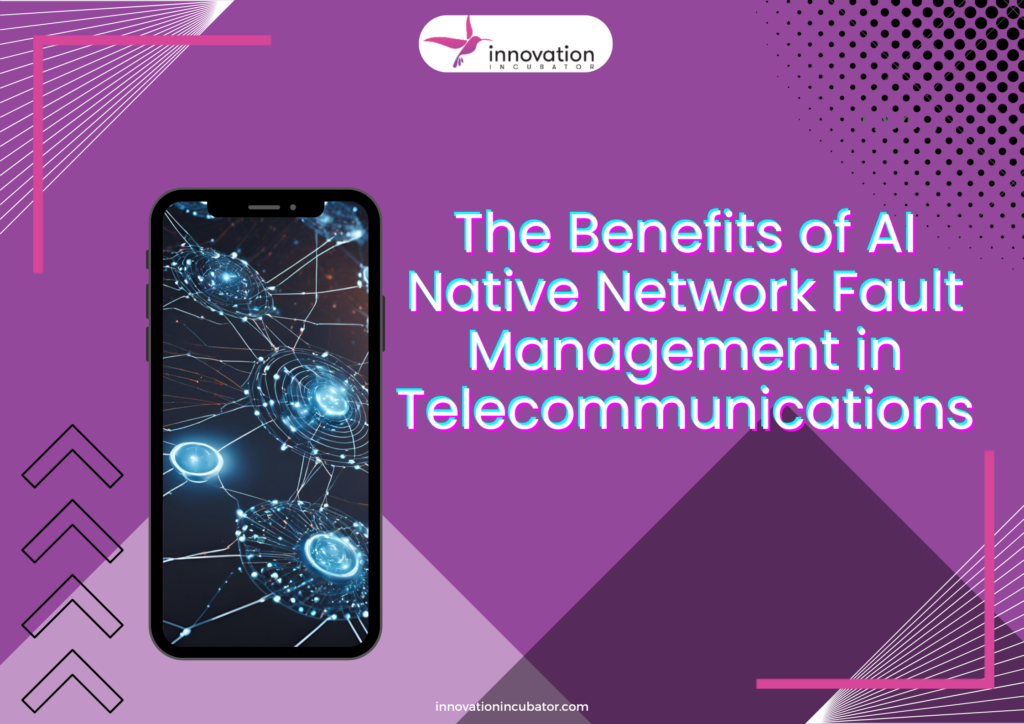In the dynamic and ever-evolving telecommunications industry, ensuring the resilience and reliability of networks is crucial. With the advent of artificial intelligence (AI), network fault management in telecommunications have seen a significant transformation. AI native fault management in telecommunication networks leverages advanced algorithms and machine learning to enhance the detection, diagnosis, and resolution of network issues. This blog will explore the benefits of integrating AI into network fault management, emphasizing how it revolutionizes telecommunication networks and why Innovation Incubator is at the forefront of this technological advancement.
1. What is AI Native Fault Management in Telecom?
AI native fault management in telecom refers to the integration of AI technologies into the traditional fault management processes within telecommunication networks. These AI-driven systems can autonomously monitor, detect, and resolve network faults, significantly improving the efficiency and effectiveness of network operations. By utilizing AI, fault management tools in telecom can predict potential issues before they arise and offer real-time solutions, minimizing downtime and enhancing service reliability.
Benefits of AI Native Network Fault Management:
- Predictive Analytics: AI-powered fault management systems in telecom utilize predictive analytics to anticipate potential network failures. This proactive approach enables telecom operators to address issues before they impact service delivery.
- Automated Troubleshooting: With AI, fault management in telecommunication networks can automatically diagnose and resolve common issues without human intervention, reducing the time and resources required for problem-solving.
- Enhanced Decision-Making: AI native systems provide telecom operators with data-driven insights, allowing for more informed decision-making and strategic planning.
2. Why AI Native Fault Management is Transforming Telecommunication Networks
The integration of AI into network fault management in telecommunications has introduced a new era of efficiency and reliability in telecommunications. AI native fault management in telecommunication networks offers several transformative benefits that traditional systems cannot match:
a. Accelerated Fault Detection and Resolution
- AI native fault management tools in telecom can process vast amounts of data in real time, identifying patterns and anomalies that may indicate potential faults. This capability allows for much faster detection and resolution of issues compared to manual or traditional automated systems.
b. Minimized Human Error
- Human intervention in network fault management often carries the risk of errors. AI systems reduce this risk by automating the detection and resolution processes, ensuring a more consistent and accurate response to network issues.
c. Scalability and Flexibility
- AI native fault management systems are highly scalable, capable of handling the growing complexity of modern telecommunication networks. Whether dealing with a small regional network or a vast global infrastructure, AI systems can adapt to various scales and complexities.

3. Key Features of AI Native Fault Management Systems
AI native fault management in telecom is characterized by several key features that distinguish it from traditional systems. These features are crucial in enhancing the overall effectiveness and efficiency of fault management in telecommunication networks.
a. Machine Learning and Continuous Improvement
- AI native fault management systems employ machine learning algorithms that enable them to learn from past incidents and continuously improve their fault detection and resolution capabilities. Over time, these systems become more accurate and efficient.
b. Real-time Data Processing
- The ability to process data in real time is a hallmark of AI native systems. This allows for the immediate identification of issues and swift corrective action, minimizing the impact of faults on network performance.
c. Intelligent Automation
- AI driven automation goes beyond simple rule-based processes. AI native fault management tools in telecom can analyze complex data sets, make decisions based on contextual information, and execute actions that were traditionally reserved for human operators.
4. Applications of Large Language Models (LLMs) in AI Native Fault Management
Large Language Models (LLMs), like GPT-4, are becoming increasingly integral to AI native fault management in telecommunication networks. These models offer several unique applications that enhance the capabilities of fault management systems:
a. Advanced Natural Language Processing (NLP) for Alert Management
- LLMs can analyze and interpret alerts generated by network monitoring tools in natural language. This allows for more intuitive interactions with fault management systems, enabling operators to query the system in plain language and receive detailed explanations and recommendations.
b. Enhanced Root Cause Analysis
- Using the vast knowledge encoded within LLMs, AI native fault management systems can perform more sophisticated root cause analyses. By cross-referencing current faults with historical data and global knowledge bases, LLMs help identify underlying issues more accurately and quickly.
c. Automated Report Generation
- LLMs can automate the creation of detailed reports on network performance and fault incidents. These reports, generated in clear and accessible language, help telecom operators and stakeholders understand complex technical issues without requiring deep technical expertise.
d. Proactive Customer Support
- By integrating LLMs with customer support systems, telecom companies can offer more proactive and personalized assistance. LLMs can predict common customer issues based on network data and provide real-time support or notifications to end-users before they even realize there’s a problem.
5. How Innovation Incubator is Pioneering AI Native Network Fault Management
Innovation Incubator is a leader in the development and implementation of AI native solutions for network fault management in the telecom industry. By integrating advanced AI technologies, including LLMs, into their fault management systems, Innovation Incubator helps telecom companies achieve unprecedented levels of network reliability and performance. Their AI native fault management tools in telecom are designed to meet the specific needs of modern telecommunication networks, offering flexibility, scalability, and unmatched efficiency.

6. The Role of AI in Managing Large-Scale and Geographically Dispersed Networks
One of the most significant advantages of AI native fault management in telecom is its ability to manage large-scale and geographically dispersed networks. As telecommunication networks expand and become more complex, AI native systems offer several benefits:
a. Geographically Targeted Fault Management
- AI native systems can monitor and manage faults in specific geographic regions, ensuring that even remote or hard-to-reach areas receive the same level of attention as more accessible parts of the network.
b. Handling Network Complexity
- As networks grow in complexity, traditional fault management systems may struggle to keep up. AI native fault management tools in telecom are designed to handle complex network structures, ensuring that all components, regardless of their location, are effectively managed.
7. Common Questions About AI Native Network Fault Management
Q1: What are the primary advantages of using AI native fault management systems in telecom?
- AI native systems offer predictive analytics, real-time data processing, intelligent automation, and the application of LLMs, leading to faster fault detection, reduced human error, and enhanced network reliability.
Q2: How does AI native fault management improve network performance?
- By autonomously detecting and resolving faults in real time, AI native systems ensure that networks operate at optimal levels, minimizing downtime and improving overall service quality.
Q3: Are AI native fault management tools in telecom scalable?
- Yes, AI native systems are highly scalable and can adapt to networks of varying sizes and complexities, making them suitable for both small regional networks and large global infrastructures.
Q4: What role does Innovation Incubator play in advancing AI native fault management?
- Innovation Incubator is at the forefront of integrating AI technologies, including LLMs, into network fault management systems, providing telecom companies with state-of-the-art tools to enhance network reliability and performance.
8. Conclusion
AI native fault management in telecom represents a significant leap forward in the management and maintenance of telecommunication networks. By leveraging the power of AI and LLMs, these systems offer unprecedented levels of efficiency, reliability, and scalability. Innovation Incubator is leading the charge in this technological revolution, providing telecom companies with the tools they need to ensure their networks are resilient and capable of meeting the demands of the future.
For more information on how Innovation Incubator can help your company with AI native fault management in telecommunication networks, visit our website.

